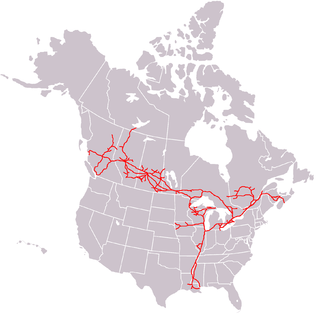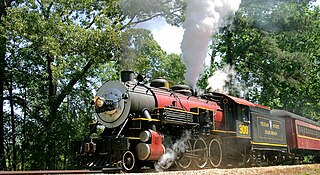
The Union Pacific Railroad is a Class I freight-hauling railroad that operates 8,300 locomotives over 32,200 miles (51,800 km) routes in 23 U.S. states west of Chicago and New Orleans. Union Pacific is the second largest railroad in the United States after BNSF, with which it shares a duopoly on transcontinental freight rail lines in the Western, Midwestern and West South Central United States.

The Canadian National Railway Company is a Canadian Class I freight railway headquartered in Montreal, Quebec, which serves Canada and the Midwestern and Southern United States.

CSX Transportation, known colloquially as simply CSX, is a Class I freight railroad company operating in the Eastern United States and the Canadian provinces of Ontario and Quebec. Operating about 21,000 route miles (34,000 km) of track, it is the leading subsidiary of CSX Corporation, a Fortune 500 company headquartered in Jacksonville, Florida.

The Southern Pacific was an American Class I railroad network that existed from 1865 to 1996 and operated largely in the Western United States. The system was operated by various companies under the names Southern Pacific Railroad, Southern Pacific Company and Southern Pacific Transportation Company.

The Monson Railroad was a 2 ft narrow gauge railway, which operated between Monson Junction on the Bangor and Aroostook Railroad and Monson, Maine. The primary purpose of this railroad was to serve several slate mines and finishing houses in Monson. According to the Scientific American of 17 May 1890, it was the smallest railroad in the United States.

The St. Louis Southwestern Railway Company, known by its nickname of "The Cotton Belt Route" or simply "Cotton Belt", is a former Class I railroad that operated between St. Louis, Missouri, and various points in the U.S. states of Arkansas, Tennessee, Louisiana, and Texas from 1891 to 1980, when the system added the Rock Island's Golden State Route and operations in Kansas, Oklahoma, and New Mexico. The Cotton Belt operated as a Southern Pacific subsidiary from 1932 until 1992, when its operation was assumed by Southern Pacific Transportation Company.

The Texas, Oklahoma and Eastern Railroad is a Class III short-line railroad owned by Patriot Rail Company of Jacksonville, Florida, with 39.3 miles of track in southeastern Oklahoma. It is operated along with its affiliate, the De Queen and Eastern Railroad, in southwest Arkansas, as a single combined railroad with 91 miles of track. Specifically, the TOE runs from Valliant, Oklahoma through Wright City, Broken Bow, and Eagletown to the Oklahoma/Arkansas border, where the DQE continues through De Queen, Lockesburg and Dierks to Perkins, Arkansas.

The Mount Hood Railroad is a heritage and shortline freight railroad located in Hood River, Oregon, 60 miles (97 km) east of Portland, Oregon, United States.

The McCloud Railway was a class III railroad operated around Mount Shasta, California. It began operations on July 1, 1992, when it took over operations from the McCloud River Railroad. The MCR was incorporated on April 21, 1992.

The Oregon, Pacific and Eastern Railway is an Oregon-based short line railroad that began near Eugene as the Oregon and Southeastern Railroad (O&SE) in 1904. O&SE's line ran 18 miles (29 km) along the Row River between the towns of Cottage Grove and Disston. The Oregon, Pacific & Eastern Railway Company incorporated in 1912, purchased the physical assets of the O&SE two years later, and shortened their total trackage to operate 16.6 miles (26.7 km) from an interchange yard with the Southern Pacific Railroad at Cottage Grove, east to a 528' x 156' turnaround loop at Culp Creek. The last of this track was closed and scrapped in 1994, and ownership of its abandoned right of way property was later reverted to the state of Oregon to become one of the first-ever Government/Private Sector cooperative partnership Rails to Trails programs in the US, forming the Row River National Recreation Trail. A successor corporation now operates a communications company and a narrow-gauge line at Wildlife Safari.
The Moscow, Camden & San Augustine Railroad Company is a Class III short line railroad headquartered in Camden, Texas. It is a subsidiary of Georgia-Pacific.
Pickens Railway is a shortline railroad that has operated on two separate divisions in the Upstate Region of South Carolina:
Southern Pacific Transportation Company formed the Oregon and Eureka Railroad Company in 1903 in an agreement to use logging railroads as part of a line connecting Humboldt County (California) sawmills with the national rail network. Northwestern Pacific Railroad offered service over the route from 1911 through 1933. The northern 6-mile (9.7 km) of the line remained in use as a Hammond Lumber Company logging branch until 1948.

Southern Pine Lumber Company No. 28 is a preserved 2-8-0 “Consolidation” steam locomotive that was originally operated by the United States Army Transportation Corps. It is one of three survivors out of over 1,500 General Pershing locomotives built in 1917 for the War Department in World War I, originally numbered 396. After the war, the locomotive was sold off to the Claiborne and Polk Railroad for short distance freight service, and from there, it was sold multiple times throughout its revenue career, until 1956, when it was sold to the Southern Pine Lumber Company in East Texas, where it operated until it was retired in the early 1970s. In 1972, the locomotive was donated to the Texas Parks and Wildlife Department, who moved it to the Texas State Railroad for restoration four years later. After over twenty years of being stored, awaiting for restoration to come to fruition, the locomotive was fired up again in April 1996 as TSRR No. 300. It has pulled multiple excursion trains between Rusk and Palestine every year since its return to steam alongside a few other steam locomotives, including 2-8-2 No. 400. As of 2024, the locomotive was reverted to one of its original identities as SPLCO No. 28, but is currently getting its running gear repaired in Rusk.
The Texas Southern Railway, now defunct, was an American shortline railroad based in Marshall, Texas.
The Waco, Beaumont, Trinity and Sabine Railway (WBT&S) was a standard gauge U.S. shortline railroad located in East Texas. The company was formed from two earlier shortlines that interchanged in Trinity, Texas, and had come under the control of the Missouri, Kansas and Texas Railway, but were spun off in 1923 as part of that company's bankruptcy reorganization. The WBT&S itself declared bankruptcy in 1930 and would operate under receivership for the rest of its existence—the longest bankruptcy in Texas rail history.














